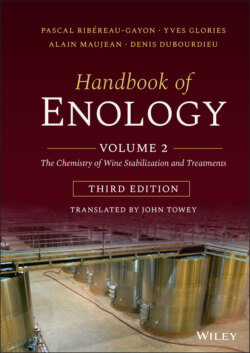Читать книгу Handbook of Enology, Volume 2 - Pascal Ribéreau-Gayon - Страница 66
2.5.4 Esters of Chemical Origin
ОглавлениеThe formation of esters continues throughout the aging process, thanks to the presence of nonvolatile acids in wine together with large quantities of ethanol. Research into esterification mechanisms in wine (Ribéreau‐Gayon et al., 1982) showed that, under normal cellar conditions, none of the acids ever reach the equilibrium predicted in theory. The ester content represents approximately 30% of the theoretical limit after 1 year, 50% after 2 or 3 years, and 80% after 50 years. The total ester concentration (regardless of its origins) is governed by the wine's composition and age. It varies from 2 or 3 mEq/l in young wines up to 9 or 10 mEq/l in old wines, in which approximately 10% of the acids are esterified.
Mono‐acids react with ethanol to form only neutral esters, whereas di‐acids may produce one neutral and one acidic ester (e.g. ethyl tartrate and ethyl hydrogen tartrate). On average, wine contains approximately the same quantity of neutral and acidic esters. The latter contribute to wine acidity.
Ethyl lactate is a special case. Its formation is linked to malolactic fermentation, with the possible involvement of an esterase of bacterial origin. However, concentrations of ethyl lactate also increase throughout aging via chemical reactions. In Champagne wines that have completed malolactic fermentation, the ethyl lactate concentration has been observed to increase to a maximum of 2 g/l after two years and then decrease during further aging on the lees. According to Arctander (1969), ethyl lactate has an odor reminiscent of butter or even sour milk. Other authors think that the odor of ethyl lactate has been confused with that of other aroma compounds.
